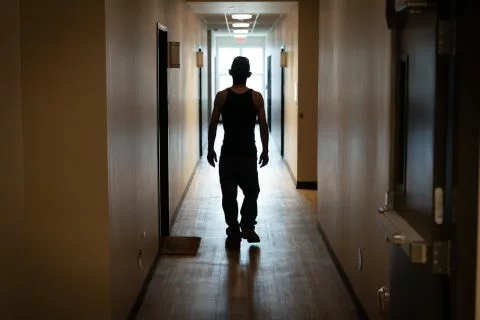- Michigan has begun to receive its $1.6 billion share of national opioid settlement dollars — half of which is directed to local governments
- Much of that money sits unspent in county accounts
- Nearly 3,000 Michiganders died last year from overdoses
Half of Michigan counties have yet to spend a dime of opioid funds intended to save lives, almost a year and a half after they began receiving tens of millions of dollars to fight the epidemic.
A survey released Friday conducted by the Michigan Association of Counties found that less than half of the 64 counties that responded had a plan ensuring funds reach those most profoundly impacted by the crisis. One-third of counties have not involved community groups or those who are in recovery from addiction in their planning.
Every day with money unspent is another day of overdoses, said Mike Hirst, who founded a nonprofit that inspired a Jackson recovery housing project, Andy’s Place. It is named after his son, who died of a heroin overdose in 2010.
“When you’re in front of a problem like this, you don’t have a lot of patience because every day that (spending) is not happening, there’s somebody dying,” Hirst said.
Related stories:
The survey results highlight the growing divide between advocates frustrated with the slow rollout of financial support, and state and local officials who believe months of planning and meetings will lead to better long-term outcomes.
“Because this is a once in a lifetime opportunity, they’re trying to figure out how to manage thoughtful planning while also understanding the urgency of the crisis,” said Amy Dolinky, technical adviser at the Michigan Association of Counties that conducted the survey.
The state is not tracking what will eventually amount to more than $700 million in local opioid settlement funds, making the association’s survey the most complete picture to date about the pace at which counties are spending those dollars.
Over 18 years, Michigan will receive about $1.6 billion in funds from settlements with manufacturers, distributors and pharmacies that played a role in the expansion of opioid use.
About half the funds are going directly to counties, cities and townships, with the rest sent to the state, which can use the funds as it chooses to fight the crisis.
By the end of 2023, Michigan had collected $181 million, with $67 million of that going to local governments.
Bridge reported in February that officials in Michigan counties, cities and townships have struggled to decide how best to spend their opioid funds, to the exasperation of me service providers.
Bridge was unable at that time to tally how much had been spent, but groups including the Michigan Association of Counties said they believed less than half of counties had spent funds yet.
The new survey, which includes responses from about 75% of Michigan’s 83 counties, confirms that assumption.
Among other findings of the survey:
- One-third of counties have a plan in place for spending opioid settlement funds, up from just 4% in a similar survey last year; 23% haven’t even started a planning process, down from 47% last year.
- Among counties that have distributed some of their funds, the most common spending was for prevention and treatment services, and expanded access to Naloxone, a drug that reverses opioid overdoses.
- Just two counties reported having spent all the settlement funds they received in 2023.
- Less than half of the counties, 48%, have publicly accessible information about opioid settlement spending
Advocates hope the unparalleled windfall will be a turning point in a decades-long opioids fight, which kills almost 3,000 Michigan residents a year, more than car crashes and guns combined.
Opioids, which include heroin and man-made drugs such as fentanyl, are the cause of 80% of drug deaths in the state, with a Michigander dying of an opioid-related overdose every four hours.
“People need help — yesterday,” Laura Rousseau, president of Face Addiction Now of Northwest Wayne, formerly Families Against Narcotics of Northwest Wayne, told Bridge Michigan in March following a meeting with Attorney General Dana Nessel.
Dolinky of the county group defended governments’ cautious approach to spending money that ranges from $23,000 total for Keweenaw County to $71 million flowing into the coffers of Wayne County.
“The initial delay in spending will hopefully be (offset) by dollars being spent responsibly and geared toward those most affected by the crisis,” Dolinky said.
One example of cautious spending is Ogemaw County in northern Michigan.
The county has received about $800,000 so far out of the $3.7 million it’s expected to get over the course of 18 years of payments. County Administrator Tim Dolehanty told Bridge Michigan that the county has so far spent about $30,000, which is less than 4% of the settlement funds it has in the bank.
The country has transferred about $20,000 to a drug task force operated by local police, and about $10,000 for defibrillators.
“I’m hoping the planning process will be over this summer, and we can start providing more (funds) for services,” Dolehanty said.
“Opioid dollars are meant to clean up the mess that was made by the people on the other end of these settlements,” he said, “so it’s important to not spend money on things that aren’t useful.
“I just want to make sure we have no regrets.”
Washtenaw County will have $4 million in opioid settlement funds available by the end of 2024, and hasn’t spent any yet. County health officer Jimena Loveluck said the county formed a steering committee this year to conduct a needs assessment.
“Given the level of funding available, it is important to ensure that the funds are used in a manner that will address local needs most effectively and that those priorities are identified through the engagement of community members and people with lived experience,” Loveluck told Bridge in a written statement. “This thorough needs assessment process takes time but will ensure all voices are heard.”
Planning that drags on for more than a year is frustrating when spending needs have “accelerated,” said Rousseau of the Face Addiction Now group
Among the biggest needs, Rousseau told Bridge, is clean and safe housing for people in early recovery, Narcan, syringe exchange programs, and other harm reduction efforts. And there’s a desperate need for peer recovery coaches — people in recovery who help others get there.
In March, Rousseau was in a meeting with Nessel in Canton, at which Nessel planned to highlight how Wayne County providers were spending opioid settlement dollars.
Providers has no success stories to tell. They told Nessel that they were still awaiting those funds.





